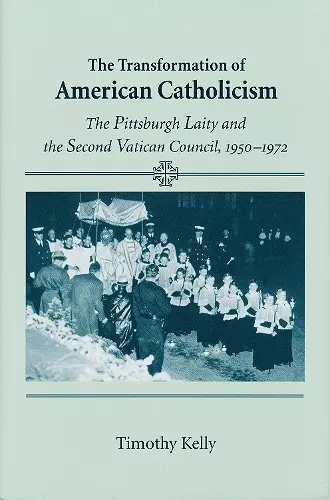Transformation of American Catholicism
The Pittsburgh Laity and the Second Vatican Council, 1950-1972
Format:Hardback
Publisher:University of Notre Dame Press
Published:15th Jan '09
Currently unavailable, and unfortunately no date known when it will be back

Most scholars and media analysts have suggested that Vatican II revolutionized American Catholicism, with the changes it mandated filtering down from the Council to the church hierarchy to the laity.
Timothy Kelly's book challenges this assumption, based on his careful tracing of Catholic lay practices in the Pittsburgh Diocese from the 1950s through the 1970s. The lay experience of American Catholics did change dramatically in the 1960s, but Kelly argues that the transformation began earlier, before the Council, and continued throughout the next decade. Kelly examines the discourse of Catholicism in the 1950s and compares this to actual lay behavior. He discusses critical changes introduced by Vatican II and follows the lay response for a decade after the last Council sessions to illuminate Catholic efforts to implement the changes in everyday practice. His individual chapters focus on devotional behavior, liturgical reforms, and broader social and cultural issues.
Kelly's social history reveals that Vatican II was not a shock to a complaisant and unquestioning laity as much as a reform necessary to keep pace with changing religious, social, and cultural sensibilities. As Catholics rejected a heavily devotional religiosity, they sought instead practices that resonated more with their lived experiences. An emphasis on social justice grew, but lay Catholics had not yet charted a clear path by the end of the Council's last session, and by that time, church officials had begun to resist some of the Vatican II reforms. A fascinating study of the most profound transformation in American Catholicism in the last century, Kelly's work is an important contribution to Catholic history.
“Timothy Kelly has in The Transformation of American Catholicism provided a scholarly, yet highly readable and significant account, which helps to correct the lacunae in academic works concerning the impact of Vatican II on the laity. Timothy Kelly’s book is of great value to scholars, students of American Catholic history, and the faithful in Pittsburgh, all of whom will find much food for thought in this volume.” —Church History
“Kelly analyzes how Catholics in southwestern Pennsylvania built their religious identity in the 1950s and the struggles they faced following the Second Vatican Council, which changed many cherished beliefs and practices. Kelly identifies three in particular: first, devotional life (e.g., rosaries at home, lay retreats, and huge Euharistic rallies at Forbes Field for men); second, building ‘a Catholic ghetto’ (parochial schools, Legion of Decency pledges, sanctions against mixed faith marriages); third, abhorrence of Communism and materialism. . . . Kelly’s work shows painstaking scholarly analyses.” —American Catholic Studies
“The Transformation of American Catholicism complements a growing body of work that reveals how the Second Vatican Council fits within a longer history of changes already taking place in the Catholic Church. Kelly’s astute employment of diocesan newspapers and archival documentation makes for a convincing characterization of Pittsburgh Catholicism as a test case for the rest of the United States. . . . a must-read for those specializing in the history of Catholicism in the twentieth century and a model for future studies of the Second Vatican Council’s impact on the daily lives of the laity and the clergy in the United States.” —Catholic Library World
“The basic premise of the book is that much of the impetus for change in the Church was driven not by the hierarchy but by the laity and, furthermore, that the seeds of this movement can be seen in the immediate preconcilar era.” —Catholic Books Review
"Kelly's basic argument convinces us that the changes in the church attributed to the council were well underway years prior to the council in the lives of the Catholic laity. . . . Kelly's research demonstrates that many Pittsburgh lay Catholics, having ratified their vision of what it means to be church, will continue to speak. But will Rome even listen? Kelly does not abandon all hope. Rather, he suggests that the lay Catholic experience of the 1950s and '60s may prove instructive at these dark moments of crisis in the church—that what was once achieved by the laity can be achieved again." —The National Catholic Reporter
"Timothy Kelly's well-grounded case study, featuring exceptionally detailed research enlivened by vigorous narrative, is a provocative and valuable contribution to the literature on twentieth-century U.S. Catholicism." —James Fisher, Fordham University
“Case studies of the rich history of American Catholicism have already advanced our knowledge of the interactions between religion and social experience. Timothy Kelly's imaginative exploration of Pittsburgh's involvement in the transformations of modern Catholicism shoots right to the top of the list, in showing the complex linkages among laity, clergy, and the larger Church in causing and processing change.” —Peter N. Stearns, Provost, George Mason University
“Finally, a book that looks at how real Catholics negotiated the societal and religious changes of the fifties and sixties. Kelly has accomplished the hard task of assembling a social history of a people in transition. His painstakingly careful research is particularly sensitive to how Catholics dealt with the changing status of women and the racial geography of Pittsburgh. From the bottom up we see how American Catholics were reworking their religion long before the advent of the Second Vatican Council.” —Colleen McDannell, Professor and Sterling M. McMurrin Professor of Religious Studies, University of Utah
ISBN: 9780268033194
Dimensions: 229mm x 152mm x 22mm
Weight: 673g
378 pages